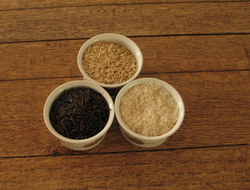Brown Rice versus White Rice
Published: October 15, 2020
Rice is considered a staple cereal grain for more that 50% of the world’s population providing, on average, 20% of total calories consumed by people worldwide.
It is a particularly important food in Asia, several countries in the Americas and Africa, and its production is only surpassed by sugar cane and maize.
Wheat and maize supply 19% and 5% of the world’s calorific requirement respectively.
The nutrient content of rice depends on several factors:
- The colour of the rice (white, brown, red and black)
- The nutrient content of the growing medium
- Processing and polishing, enrichment and cooking method
Brown rice has the "husk" or outermost layer removed where as white rice has the husk, the bran layer, and the germ removed.
Any nutritional difference that occurs is due to the nutrients that are in the bran layer and the germ.
Thus un-milled or partly milled brown rice contains more nutrients, particularly fibre, which has a variety of health benefits, than white rice.
For instance, both brown and white rice contain similar amounts of carbohydrate and protein, but varying amounts of vitamins: thiamin, riboflavin, niacin, vitamin B6, and pantothenic acid.
Minerals include calcium, copper, iron, magnesium (brown rice has significantly more), manganese, phosphorus, potassium, selenium, sodium and zinc.
In addition to these nutrients brown rice also contains small amounts of fats including omega-3 and omega-6 fatty acids which can contribute to your daily requirement, and vitamin K.
Antioxidants such as anthrocyanins and tocols give black and purple rice colour and are found predominantly in the inner portion of the bran of these grains.
Healthy eating recommendations suggest that 50% of grain foods that you consume should be whole grain. However, white rice is generally favoured over brown rice in part due to differences...link to the full article to learn more.
Related Topics
Diet Health Food Choices Cooking Methods Nutrients Carbohydrates Protein Micronutrients Minerals VitaminsReferences
1.
Jackson et al. (2012). Arsenic, organic foods and brown rice syrup. Environmental Health Perspectives. 120 (5).
2.
Meharg, A. et al. (2008). Speciation and Localization of Arsenic in White and Brown Rice Grains. Environ. Sci. Technol. 42, 1051–1057
3.
Hallfrisch, J., Scholfield, DJ., Behall, KM. (2003). Blood pressure reduced by whole grain diet containing barley or whole wheat and brown rice in moderately hypercholesterolemic men. Nutrition research. 23/12
4.
Wu et al. (2010). Germinated Brown Rice and Its Role in Human Health. Critical Reviews in Food Science and Nutrition, 53:5, 451-463
5.
Tian et al (2004). Analysis of Phenolic Compounds in White Rice, Brown Rice, and Germinated Brown Rice. J. Agric. Food Chem. 2004, 52, 4808-4813
6.
Centre for science in the public interest (March 2013, July/August 2010

